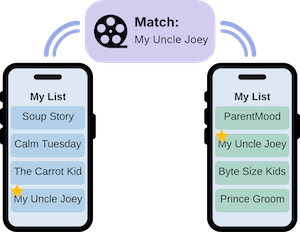
LocalApps.com: Mobile Apps, User-Controlled
Create iOS apps that can work offline, store data locally, and enable peer-to-peer sharing with no logins or cloud storage, and complete user control.
What if we built apps to be Local-Only
from the start?
Most mobile apps force developers to build backend infrastructure even for simple tasks that could work entirely offline. Local-Only apps flip the model: they store data locally, work offline, and connect peer-to-peer — no logins, no tracking, and no cloud required.
Consider this: Two people picking a movie together. Their phones connect directly. Movie queues merge instantly. Just the two of you, deciding together.
This isn't about movies — it's about rethinking how apps work fundamentally.

After building software for startups, enterprises, and everything in between, one truth stands out: we've accepted cloud-first as the default — but there's an opportunity to rethink how we build software, putting users in control while still creating successful products.
Success Without the Cloud
For Developers
- ✓ No backend infrastructure to build or maintain
- ✓ Predictable performance without network dependencies
- ✓ Competitive advantage through differentiated user experience
For Users
- ✓ Complete ownership of their data and decisions
- ✓ Apps that work reliably without connectivity dependencies
- ✓ Sharing without corporate intermediaries
The Local-Only Framework
It's private. It's local. And it puts users in control.
Four core principles make this possible:
Your data stays on your device
No cloud, no accounts, no tracking. Just privacy by design.
Sharing happens nearby
Phones connect peer-to-peer — instantly, securely, without internet.
Device as Authority
Authority patterns instead of consensus models. Simple delegation, clear control. This is enabled by P2PDA (Peer-to-Peer Device Authority) — the software architecture pattern that makes Local-Only sharing possible.
Data In, Insight Out — But Locally
Apps can fetch useful data — like bank transactions or schedules — but analysis and insights happen on-device. No cloud storage. No outbound exposure.
These aren't limitations — they're the foundation of something better. A new model for apps that are safer to use and fundamentally more human.
Six Ways to Share with Device Authority
These patterns demonstrate Device as Authority in action. One device controls the data (🔒) and shares directly with others — from simple cross-device access to complex group interactions.

The Local-Only Roadmap
Evaluate
Determine if your app is a candidate for Local-Only by applying the core principles: Your data stays on your device, Sharing happens nearby, P2PDA (Peer-to-Peer Device Authority), Data In, Insight Out — But Locally.
Architect
Design your app using Local-Only patterns — from on-device storage to secure peer-to-peer communication.
Build
Develop and test your app using Local-Only development patterns — and bring it to market without building or managing backend services.
What You Gain by Going Local-Only
| Cloud-First Pitfalls | Local-Only Advantages |
|---|---|
| Costly backend upkeep | No infrastructure to maintain |
| Slow, laggy UX | Predictable performance |
| Data collection by default | Privacy built-in |
| Offline support bolted on | Works offline by default |
| Subscription pressure | One-time purchase possible |
Ready to Build Local-Only Apps?
Start with the key principles, and explore the tools and patterns that make it possible.